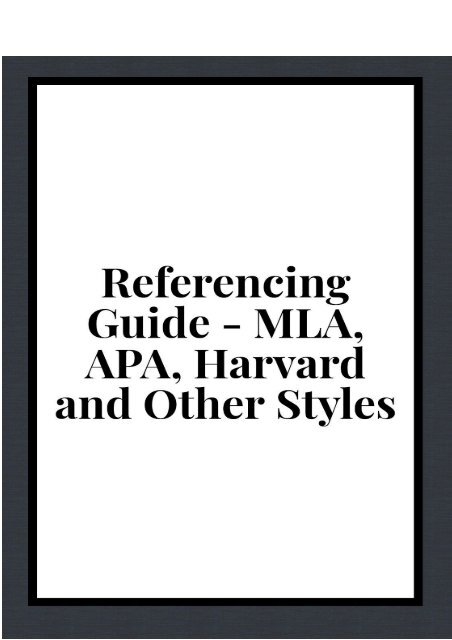Referencing Guide - MLA, APA, Harvard and Other Styles
Hi! Check this article and explore this referencing guide - MLA APA, Harvard and other styles. Learn more here http://www.referencegenerator.net/
Hi! Check this article and explore this referencing guide - MLA APA, Harvard and other styles. Learn more here http://www.referencegenerator.net/
Create successful ePaper yourself
Turn your PDF publications into a flip-book with our unique Google optimized e-Paper software.
<strong>Referencing</strong> <strong>Guide</strong> - <strong>MLA</strong>, <strong>APA</strong>, <strong>Harvard</strong><br />
<strong>and</strong> <strong>Other</strong> <strong>Styles</strong><br />
Prior to writing an academic work, you need to make sure which is the<br />
official referencing style of the school you’re attending. If you don’t know, you<br />
can simply ask one of your professors, then use a reference generator<br />
accomplish the job in the most quick <strong>and</strong> efficient manner possible. But first,<br />
it’s important to get familiar with the most commonly used styles so you’ll be<br />
able to differentiate between them with relative ease.<br />
<strong>MLA</strong> format bibliography generator <strong>and</strong> other styles overlook<br />
1. The <strong>MLA</strong> referencing style<br />
Examining the examples any <strong>MLA</strong> format works cited page generator<br />
outputs, you’ll be able to observe this is mainly is a system of brackets. At the<br />
end of your essay is where full length citations can be found, <strong>and</strong> through the<br />
use of <strong>MLA</strong> format, you’re simply pointing that out.
So what’s in the brackets? As a typical <strong>MLA</strong> format bibliography<br />
generator will show you, the brackets only contain the author’s surname <strong>and</strong> the<br />
page number you’re trying to point the reader to.<br />
Example:<br />
Just a r<strong>and</strong>om statement (Doe, 14).<br />
In case you’re mentioning two or more essays by the same author, specify<br />
which one you’re referring to in order to avoid confusion.<br />
Example:<br />
Just a r<strong>and</strong>om statement (Doe, Revelations, 14).<br />
Of course, you can also use a <strong>MLA</strong> format cite generator to do the work<br />
for you. By using a reference generator <strong>MLA</strong>, you just input the variables, <strong>and</strong><br />
the script will do the rest for you automatically.<br />
2. The <strong>APA</strong> referencing style<br />
As observed in the result of an <strong>APA</strong> style bibliography maker, this system<br />
also includes brackets. Basically, it includes the author’s surname, the date of<br />
the publication <strong>and</strong> the exact number you are referring to.<br />
Example:<br />
Just a r<strong>and</strong>om statement (Doe, 2006, p. 14).
It’s important to note that the brackets should always be placed at the end<br />
of a statement. As always, you can do this manually or use a <strong>APA</strong> style<br />
reference generator <strong>and</strong> not worry about the rest.<br />
3. The <strong>Harvard</strong> referencing style<br />
A harvard citing generator reveals that – surprise, surprise – this is<br />
another bracket-based referencing system. This one, however, only lists the<br />
author’s surname <strong>and</strong> the publication date.<br />
At the end of the document, simply include the lists of all authors by their<br />
surnames so the reader can quickly find the original source if need be. These are<br />
formatted the same way you would use an <strong>APA</strong> system.<br />
As always, you can use a harvard style reference generator if you don’t<br />
quite feel like doing this yourself.<br />
4. The MHRA referencing style<br />
Surprisingly, this referencing style does not use brackets. Instead, floating<br />
numbers are used <strong>and</strong> each subsequent number is higher than the previous one.<br />
Then, either in the current page’s footer or at the end of the document, simply<br />
list the documents in the same order you referenced them.<br />
Conclusion<br />
That’s pretty much it! You might be thinking that having to memorize all<br />
this is a bit tedious, <strong>and</strong> it’s true, at least in the beginning when you’re still<br />
getting used to it. However, some people prefer using a generator, since it<br />
makes things so much easier <strong>and</strong> allows you to do the job faster. In the end, it’s<br />
up to you.<br />
Take a look on more detail description of<br />
each referencing style here:<br />
http://www.referencegenerator.net/



